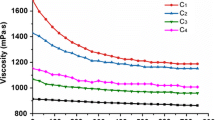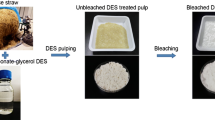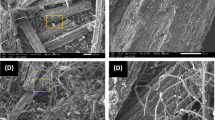Abstract
In this study, the effect of alkaline pretreatment on preparation of regenerated lignocellulose fibers from bamboo stem was studied in detail. Prior to being dissolved in [Emim]OAc, bamboo stems were ground and treated with different concentrations of sodium hydroxide solutions. The obtained spinning dopes were then extruded into water coagulation bath and regenerated to composite fibers. The properties of the raw materials, spinning dopes, and regenerated fibers were investigated. Results showed that alkaline pretreatment could break the rigid structure of lignocelluloses by removing part of hemicelluloses and lignin as well as changing the polymorphous lattice and C r I of cellulose. The increased specific surface area of raw materials enhanced the accessibility of solvent, promoted the swelling process and shortened the dissolution time. The viscosity of the spinning dopes and the strength of the regenerated fiber reached the maximum value when the bamboo powder was treated with 20 wt% sodium hydroxide at 60 °C for 4 h. In addition, the fibers prepared from the alkali-treated raw materials showed round cross-section and wrinkled surface. Therefore, the properties of the regenerated lignocellulose fibers could be improved by employing an appropriate alkali pretreatment of raw materials.









Similar content being viewed by others
References
Boudet AM, Kajita S, Grima-Pettenati J, Goffner D (2003) Lignins and lignocellulosics: a better control of synthesis for new and improved uses. Trends Plant Sci 8:576–581. doi:10.1016/j.tplants.2003.10.001
Brandt A, Gräsvik J, Hallett JP, Welton T (2013) Deconstruction of lignocellulosic biomass with ionic liquids. Green Chem 15:550–583. doi:10.1039/c2gc36364j
Chen M, Zhang X, Liu C, Sun R, Lu F (2014) Approach to renewable lignocellulosic biomass film directly from bagasse. ACS Sustain Chem Eng 2:1164–1168. doi:10.1021/sc400555v
Chen JH, Guan Y, Wang K, Zhang XM, Xu F, Sun RC (2015a) Combined effects of raw materials and solvent systems on the preparation and properties of regenerated cellulose fibers. Carbohydr Polym 128:147–153
Chen JH, Guan Y, Wang K, Xu F, Sun RC (2015b) Regulating effect of hemicelluloses on the preparation and properties of composite Lyocell fibers. Cellulose 22:1505–1516
De Micco V, Aronne G (2007) Combined histochemistry and autofluorescence for identifying lignin distribution in cell walls. Biotech Histochem 82:209–216
Dorn S (2009) Ionische Flüssigkeiten: Neue Lösemittel und Reaktionsmedien in der Cellulosechemie, PhD Thesis FSU Jena
Du XY, Gellerstedt G, Li JB (2013) Universal fractionation of lignin-carbohydrate complexes (LCCs) from lignocellulosic biomass: an example using spruce wood. Plant J 74:328–338
Eronen P, Österberg M, Jääskeläinen A-S (2009) Effect of alkaline treatment on cellulose supramolecular structure studied with combined confocal Raman spectroscopy and atomic force microscopy. Cellulose 16:167–178. doi:10.1007/s10570-008-9259-8
FitzPatrick M, Champagne P, Cunningham MF (2012) Quantitative determination of cellulose dissolved in 1-ethyl-3-methylimidazolium acetate using partial least squares regression on FTIR spectra. Carbohydr Polym 87:1124–1130
Fort DA, Remsing RC, Swatloski RP, Moyna P, Moyna G, Rogers RD (2007) Can ionic liquids dissolve wood? Processing and analysis of lignocellulosic materials with 1-n-butyl-3-methylimidazolium chloride. Green Chem 9:63. doi:10.1039/b607614a
Huber GW, Iborra S, Corma A (2006) Synthesis of transportation fuels from biomass: chemistry, catalysts, and engineering. Chem Rev 106:4044–4098
Isikgor FH, Becer CR (2015) Lignocellulosic biomass: a sustainable platform for the production of bio-based chemicals and polymers. Polym Chem 6:4497–4559
Kang Y, Ahn Y, Lee SH, Hong JH, Ku MK, Kim H (2013) Lignocellulosic nanofiber prepared by alkali treatment and electrospinning using ionic liquid. Fiber Polym 14:530–536
Kilpelainen I, Xie H, King A, Granstrom M, Heikkinen S, Argyropoulos DS (2007) Dissolution of wood in ionic liquids. J Agr Food Chem 55:9142–9148. doi:10.1021/jf071692e
Kotarska K, Swierczynska A, Dziemianowicz W (2015) Study on the decomposition of lignocellulosic biomass and subjecting it to alcoholic fermentation Study on the decomposition of lignocellulosic biomass. Renew Energ 75:389–394
Kyllonen L, Parviainen A, Deb S, Lawoko M, Gorlov M, Kilpelainen I, King AWT (2013) On the solubility of wood in non-derivatising ionic liquids. Green Chem 15:2374–2378. doi:10.1039/c3gc41273c
Lee SH, Doherty TV, Linhardt RJ, Dordick JS (2009) Ionic liquid-mediated selective extraction of lignin from wood leading to enhanced enzymatic cellulose hydrolysis. Biotechnol Bioeng 102:1368–1376
Li WY, Sun N, Stoner B, Jiang XY, Lu XM, Rogers RD (2011) Rapid dissolution of lignocellulosic biomass in ionic liquids using temperatures above the glass transition of lignin. Green Chem 13:2038–2047
Loerbroks C, Rinaldi R, Thiel W (2013) The electronic nature of the 1,4-glycosidic bond and its chemical environment: DFT insights into cellulose chemistry. Chem-Eur J 19:16282–16294. doi:10.1002/chem.201301366
Lu F, Song J, Cheng BW, Ji XJ, Wang LJ (2013) Viscoelasticity and rheology in the regimes from dilute to concentrated in cellulose 1-ethyl-3-methylimidazolium acetate solutions. Cellulose 20:1343–1352
Maki-Arvela P, Anugwom I, Virtanen P, Sjoholm R, Mikkola JP (2010) Dissolution of lignocellulosic materials and its constituents using ionic liquids-a review. Ind Crop Prod 32:175–201. doi:10.1016/j.indcrop.2010.04.005
McIntosh S, Vancov T (2010) Enhanced enzyme saccharification of Sorghum bicolor straw using dilute alkali pretreatment. Bioresour Technol 101:6718–6727
Michels C, Kosan B (2006) Beitrag zur Struktur von Lyocellfasern, ersponnen aus Aminoxidhydraten bzw. ionischen Flüssigkeiten. Lenzinger Ber 86:144–153
Michud A, Hummel M, Haward S, Sixta H (2015) Monitoring of cellulose depolymerization in 1-ethyl-3-methylimidazolium acetate by shear and elongational rheology. Carbohydr Polym 117:355–363
Muhammad N, Man Z, Khalil MAB (2012) Ionic liquid—a future solvent for the enhanced uses of wood biomass. Eur J Wood Wood Prod 70:125–133
Pan JY, Fu J, Deng SG, Lu XY (2014) Microwave-assisted degradation of lignin model compounds in imidazolium-based ionic liquids. Energ Fuel 28:1380–1386
Park YC, Kim JS (2012) Comparison of various alkaline pretreatment methods of lignocellulosic biomass. Energy 47:31–35
Peng F, Peng P, Xu F, Sun RC (2012) Fractional purification and bioconversion of hemicelluloses. Biotechnol Adv 30:879–903
Ragauskas AJ et al (2006) The path forward for biofuels and biomaterials. Science 311:484–489
Schleicher H, Philipp B, Kunze J, Fink HP (1985) Neue Ergebnisse zur Bildung und Reaktionsweise von Alkalicellulose. Lenzinger Ber 59:45–51
Simmons TJ et al (2010) Preparation of synthetic wood composites using ionic liquids. Wood Sci Technol 45:719–733. doi:10.1007/s00226-010-0395-6
Sun N, Rahman M, Qin Y, Maxim ML, Rodríguez H, Rogers RD (2009) Complete dissolution and partial delignification of wood in the ionic liquid 1-ethyl-3-methylimidazolium acetate. Green Chem 11:646. doi:10.1039/b822702k
Sun N, Li W, Stoner B, Jiang X, Lu X, Rogers RD (2011a) Composite fibers spun directly from solutions of raw lignocellulosic biomass dissolved in ionic liquids. Green Chem 13:1158–1161. doi:10.1039/c1gc15033b
Sun N, Rodriguez H, Rahman M, Rogers RD (2011b) Where are ionic liquid strategies most suited in the pursuit of chemicals and energy from lignocellulosic biomass? Chem Commun 47:1405–1421. doi:10.1039/c0cc03990j
Viell J (2014) A pre-treatment process of wood based on ionic liquids. Rwth Aachen 23:15–19
Wang H et al (2014) Physical insight into switchgrass dissolution in ionic liquid 1-ethyl-3-methylimidazolium acetate. ACS Sustain Chem Eng 2:1264–1269
Wen JL, Xiao LP, Sun YC, Sun SN, Xu F, Sun RC, Zhang XL (2011) Comparative study of alkali-soluble hemicelluloses isolated from bamboo (Bambusa rigida). Carbohydr Res 346:111–120. doi:10.1016/j.carres.2010.10.006
Zakzeski J, Bruijnincx PCA, Jongerius AL, Weckhuysen BM (2010) The catalytic valorization of lignin for the production of renewable chemicals. Chem Rev 110:3552–3599
Zavrel M, Bross D, Funke M, Buchs J, Spiess AC (2009) High-throughput screening for ionic liquids dissolving (ligno-)cellulose. Bioresour Technol 100:2580–2587. doi:10.1016/j.biortech.2008.11.052
Zheng Y, Zhao J, Xu FQ, Li YB (2014) Pretreatment of lignocellulosic biomass for enhanced biogas production. Progr Energy Combust Sci 42:35–53
Zhou LL, Wu TH, Wu Y (2012) Degradation and conversion of cellulose in ionic liquids. Prog Chem 24:1533–1543
Acknowledgments
The authors are grateful to the financial support from the Program of International S&T Cooperation of China (2015DFG31860), and the Fundamental Research Funds from the Central Universities (2015ZCQ-CL-02).
Author information
Authors and Affiliations
Corresponding author
Rights and permissions
About this article
Cite this article
Chen, JH., Xu, JK., Huang, PL. et al. Effect of alkaline pretreatment on the preparation of regenerated lignocellulose fibers from bamboo stem. Cellulose 23, 2727–2739 (2016). https://doi.org/10.1007/s10570-016-0983-1
Received:
Accepted:
Published:
Issue Date:
DOI: https://doi.org/10.1007/s10570-016-0983-1




